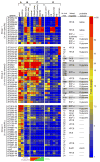Mucosal glycan foraging enhances fitness and transmission of a saccharolytic human gut bacterial symbiont
- PMID: 18996345
- PMCID: PMC2605320
- DOI: 10.1016/j.chom.2008.09.007
Mucosal glycan foraging enhances fitness and transmission of a saccharolytic human gut bacterial symbiont
Abstract
The distal human gut is a microbial bioreactor that digests complex carbohydrates. The strategies evolved by gut microbes to sense and process diverse glycans have important implications for the assembly and operation of this ecosystem. The human gut-derived bacterium Bacteroides thetaiotaomicron forages on both host and dietary glycans. Its ability to target these substrates resides in 88 polysaccharide utilization loci (PULs), encompassing 18% of its genome. Whole genome transcriptional profiling and genetic tests were used to define the mechanisms underlying host glycan foraging in vivo and in vitro. PULs that target all major classes of host glycans were identified. However, mucin O-glycans are the principal host substrate foraged in vivo. Simultaneous deletion of five genes encoding ECF-sigma transcription factors, which activate mucin O-glycan utilization, produces defects in bacterial persistence in the gut and in mother-to-offspring transmission. Thus, PUL-mediated glycan catabolism is an important component in gut colonization and may impact microbiota ecology.
Figures






Similar articles
-
Sulfatases and a radical S-adenosyl-L-methionine (AdoMet) enzyme are key for mucosal foraging and fitness of the prominent human gut symbiont, Bacteroides thetaiotaomicron.J Biol Chem. 2011 Jul 22;286(29):25973-82. doi: 10.1074/jbc.M111.228841. Epub 2011 Apr 20. J Biol Chem. 2011. PMID: 21507958 Free PMC article.
-
Coordinate regulation of glycan degradation and polysaccharide capsule biosynthesis by a prominent human gut symbiont.J Biol Chem. 2009 Jul 3;284(27):18445-57. doi: 10.1074/jbc.M109.008094. Epub 2009 Apr 29. J Biol Chem. 2009. PMID: 19403529 Free PMC article.
-
Recognition and degradation of plant cell wall polysaccharides by two human gut symbionts.PLoS Biol. 2011 Dec;9(12):e1001221. doi: 10.1371/journal.pbio.1001221. Epub 2011 Dec 20. PLoS Biol. 2011. PMID: 22205877 Free PMC article.
-
Glycan utilisation system in Bacteroides and Bifidobacteria and their roles in gut stability and health.Appl Microbiol Biotechnol. 2019 Sep;103(18):7287-7315. doi: 10.1007/s00253-019-10012-z. Epub 2019 Jul 22. Appl Microbiol Biotechnol. 2019. PMID: 31332487 Review.
-
Navigating the Gut Buffet: Control of Polysaccharide Utilization in Bacteroides spp.Trends Microbiol. 2017 Dec;25(12):1005-1015. doi: 10.1016/j.tim.2017.06.009. Epub 2017 Jul 18. Trends Microbiol. 2017. PMID: 28733133 Review.
Cited by
-
Microbiota-mediated inflammation and antimicrobial defense in the intestine.Annu Rev Immunol. 2015;33:227-56. doi: 10.1146/annurev-immunol-032713-120238. Epub 2015 Jan 2. Annu Rev Immunol. 2015. PMID: 25581310 Free PMC article. Review.
-
Genomic characterization of the uncultured Bacteroidales family S24-7 inhabiting the guts of homeothermic animals.Microbiome. 2016 Jul 7;4(1):36. doi: 10.1186/s40168-016-0181-2. Microbiome. 2016. PMID: 27388460 Free PMC article.
-
CRISPR-Cas-based identification of a sialylated human milk oligosaccharides utilization cluster in the infant gut commensal Bacteroides dorei.Nat Commun. 2024 Jan 2;15(1):105. doi: 10.1038/s41467-023-44437-y. Nat Commun. 2024. PMID: 38167825 Free PMC article.
-
Molecular analysis of the bacterial microbiome in the forestomach fluid from the dromedary camel (Camelus dromedarius).Mol Biol Rep. 2013 Apr;40(4):3363-71. doi: 10.1007/s11033-012-2411-4. Epub 2013 Jan 1. Mol Biol Rep. 2013. PMID: 23277394
-
Phocaeicola vulgatus alleviates diet-induced metabolic dysfunction-associated steatotic liver disease progression by downregulating histone acetylation level via 3-HPAA.Gut Microbes. 2024 Jan-Dec;16(1):2309683. doi: 10.1080/19490976.2024.2309683. Epub 2024 Feb 5. Gut Microbes. 2024. PMID: 38312099 Free PMC article.
References
-
- Bayer EA, Belaich JP, Shoham Y, Lamed R. The cellulosomes: multienzyme machines for degradation of plant cell wall polysaccharides. Ann Rev Microbiol. 2004;58:521–554. - PubMed
-
- Bjursell MK, Martens EC, Gordon JI. Functional genomic and metabolic studies of the adaptations of a prominent adult human gut symbiont, Bacteroides thetaiotaomicron, to the suckling period. J Biol Chem. 2006;281:36269–36279. - PubMed
-
- Braun V, Mahren S. Transmembrane transcriptional control (surface signalling) of the Escherichia coli Fec type. FEMS Microbiol Rev. 2005;29:673–684. - PubMed
Publication types
MeSH terms
Substances
Grants and funding
- R01 DK030292/DK/NIDDK NIH HHS/United States
- R01 DK070977/DK/NIDDK NIH HHS/United States
- F32 AI073060/AI/NIAID NIH HHS/United States
- P30 DK056341/DK/NIDDK NIH HHS/United States
- T32 HD07409/HD/NICHD NIH HHS/United States
- T32 HG000045/HG/NHGRI NIH HHS/United States
- K01 DK084214/DK/NIDDK NIH HHS/United States
- R37 DK030292/DK/NIDDK NIH HHS/United States
- K22 HG000045/HG/NHGRI NIH HHS/United States
- HG00045/HG/NHGRI NIH HHS/United States
- T32 GM007200/GM/NIGMS NIH HHS/United States
- DK30292/DK/NIDDK NIH HHS/United States
- GM07200/GM/NIGMS NIH HHS/United States
- T32 HD007409/HD/NICHD NIH HHS/United States
LinkOut - more resources
Full Text Sources
Other Literature Sources
Molecular Biology Databases
Research Materials

